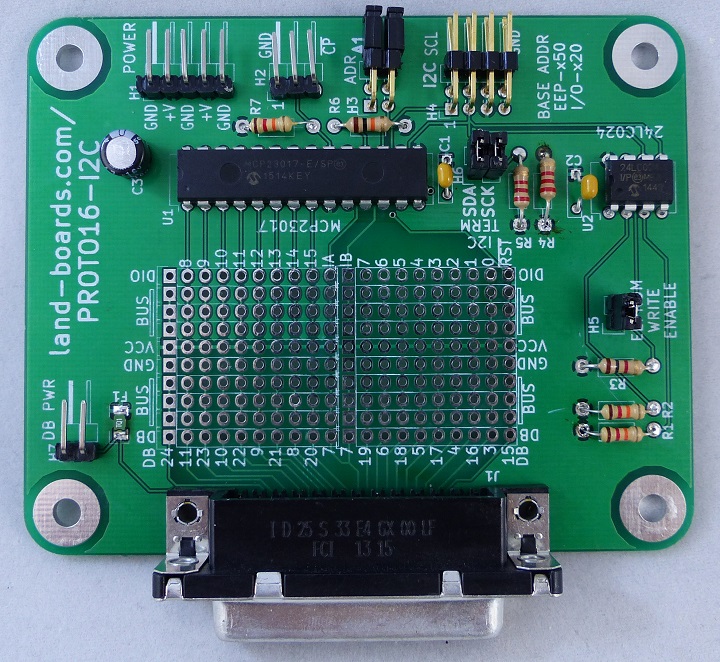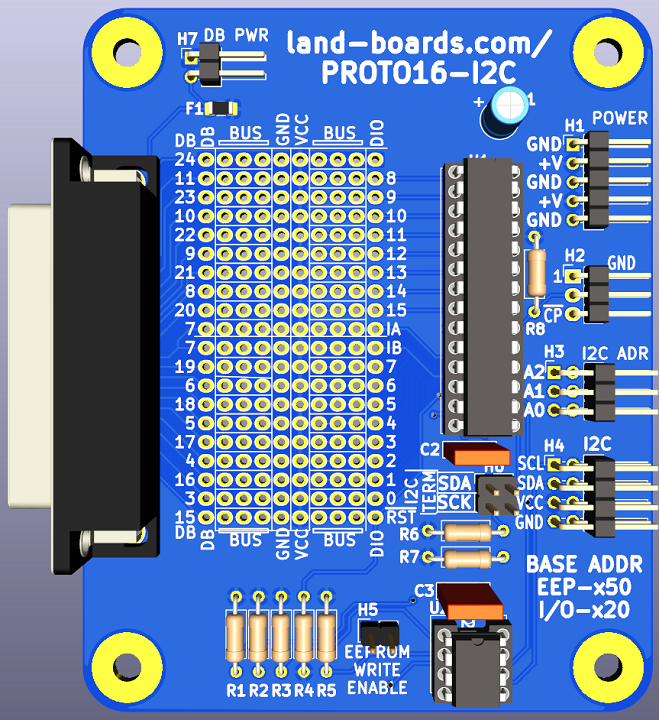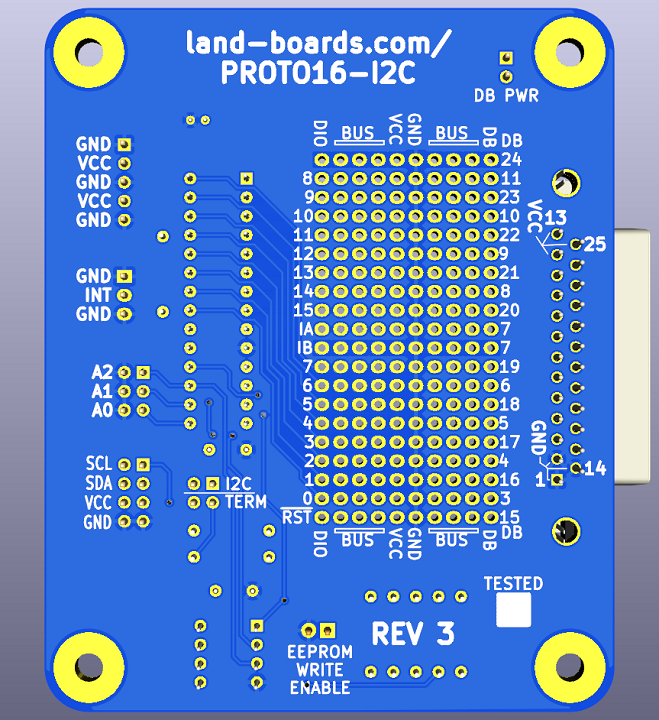Difference between revisions of "PROTO16-I2C"
Jump to navigation
Jump to search
Blwikiadmin (talk | contribs) |
Blwikiadmin (talk | contribs) |
||
| (18 intermediate revisions by the same user not shown) | |||
| Line 10: | Line 10: | ||
* 16-bit Digital I/O card | * 16-bit Digital I/O card | ||
| − | ** [ | + | ** [https://ww1.microchip.com/downloads/aemDocuments/documents/APID/ProductDocuments/DataSheets/MCP23017-Data-Sheet-DS20001952.pdf MCP23017 Datasheet] - Rev D |
| + | ** [https://hackaday.com/2023/02/03/mcp23017-went-through-shortage-hell-lost-two-inputs/?fbclid=IwAR1ktG1CsU7ns5fmTYXdlpBLdqaJmBioXrVrG1_Lgqe8MTQr1AY4rp6IETU MCP23017... LOST TWO INPUTS] | ||
| + | *** MCP23017 now a 14/16-bit expander, with two of the pins (GPA7 and GPB7) losing their input capabilities | ||
| + | *** The chips look the same, are called the same, and act mostly the same — if you don’t download the latest version of the datasheet (Revision D), you’d never know that there’s been a change | ||
** Strong library support for all major microprocessors for MCP23017 | ** Strong library support for all major microprocessors for MCP23017 | ||
* I2C Interface - Two Wire Interface | * I2C Interface - Two Wire Interface | ||
| Line 18: | Line 21: | ||
* Large prototyping area | * Large prototyping area | ||
** Connections at edges to DB-25 and GPIO lines | ** Connections at edges to DB-25 and GPIO lines | ||
| − | * EEPROM | + | * [https://www.mouser.com/ProductDetail/579-24LC024-P 24LC024] [[Open_Data_Acquisition_System#Personality_EEPROM|ODAS Personality EEPROM]] |
** Write Enable jumper protects against accidental writes | ** Write Enable jumper protects against accidental writes | ||
* [[Open Data Acquisition System]] (ODAS) form factor (width is 95 mm) | * [[Open Data Acquisition System]] (ODAS) form factor (width is 95 mm) | ||
| Line 43: | Line 46: | ||
** Easy connection to IC Power/Grounds | ** Easy connection to IC Power/Grounds | ||
* Silkscreen on both sides of the card | * Silkscreen on both sides of the card | ||
| − | |||
| − | |||
| − | |||
* The above is the top two rows of the prototyping area | * The above is the top two rows of the prototyping area | ||
* The pins on the far left are the pin number of the DB-25 connector (ex: Pin 24 is the top left, and pin 11 is in the next row). | * The pins on the far left are the pin number of the DB-25 connector (ex: Pin 24 is the top left, and pin 11 is in the next row). | ||
| Line 56: | Line 56: | ||
== Connectors == | == Connectors == | ||
| − | [[File:PROTO16-I2C- | + | [[File:PROTO16-I2C-Rev3_CONNS.png]] |
=== H1 - Power === | === H1 - Power === | ||
| + | * Connector is optional since power can also be brought in via the I2C connector | ||
* Connector is 1x5 of 0.1" header | * Connector is 1x5 of 0.1" header | ||
* Connector is reversible | * Connector is reversible | ||
| − | |||
# GND | # GND | ||
| Line 79: | Line 79: | ||
* Sets the I2C offset address of the card | * Sets the I2C offset address of the card | ||
| − | * Three bit address A1, A2 | + | * Three bit address A0, A1, A2 |
# A0 | # A0 | ||
| Line 87: | Line 87: | ||
=== H4 - I2C === | === H4 - I2C === | ||
| − | * Connector is | + | * Connector is 2x4 of 0.1" header |
* Intended to be used for I2C daisy-chain of 4-pin cabling | * Intended to be used for I2C daisy-chain of 4-pin cabling | ||
* Power can be attached to the connector or power can be provided to the card via the J1 power connector | * Power can be attached to the connector or power can be provided to the card via the J1 power connector | ||
| Line 138: | Line 138: | ||
* [https://github.com/land-boards/lb-Python-Code/tree/master/MicroPython/PyBoard%20Clone/libraries/mcp23017 MicroPython MCP23017 driver] | * [https://github.com/land-boards/lb-Python-Code/tree/master/MicroPython/PyBoard%20Clone/libraries/mcp23017 MicroPython MCP23017 driver] | ||
* [https://github.com/land-boards/lb-Python-Code/tree/master/MicroPython/ESP32/libraries/proto16 MicroPython Example code] | * [https://github.com/land-boards/lb-Python-Code/tree/master/MicroPython/ESP32/libraries/proto16 MicroPython Example code] | ||
| − | ** https://github.com/land-boards/lb-Python-Code/blob/master/MicroPython/ESP32/libraries/proto16/testProto16.py testProto16] | + | ** [https://github.com/land-boards/lb-Python-Code/blob/master/MicroPython/ESP32/libraries/proto16/testProto16.py testProto16] |
=== MicroPython Drivers === | === MicroPython Drivers === | ||
| Line 145: | Line 145: | ||
* [https://github.com/land-boards/lb-Python-Code/tree/master/MicroPython/PyBoard%20Clone/libraries/proto16 MicroPython Examples] | * [https://github.com/land-boards/lb-Python-Code/tree/master/MicroPython/PyBoard%20Clone/libraries/proto16 MicroPython Examples] | ||
** [https://github.com/land-boards/lb-Python-Code/blob/master/MicroPython/PyBoard%20Clone/libraries/mcp23017/blinkMcp23017Led.py Blink output bit] | ** [https://github.com/land-boards/lb-Python-Code/blob/master/MicroPython/PyBoard%20Clone/libraries/mcp23017/blinkMcp23017Led.py Blink output bit] | ||
| + | |||
| + | === CircuitPython (MCP23017) Drivers === | ||
| + | |||
| + | * [https://github.com/land-boards/lb-boards/blob/master/Projects/QTPy/Land%20Boards/Land%20Boards%20QT%20Py%20Code/PROTO16_Blink.py PROTO16_Blink.py] - Control the PROTO16-I2C card | ||
| + | |||
| + | === Raspberry Pi Pico === | ||
| + | |||
| + | * [https://github.com/land-boards/RasPiPico/blob/main/PicoMite_MMBASIC/PicoMite_VGA/Land%20Boards%20BASIC%20Programs/lbcards/GPIO16-02.bas MMBASIC Example Code] | ||
== Personality EEPROM == | == Personality EEPROM == | ||
| Line 155: | Line 163: | ||
* 10 mS write cycle time | * 10 mS write cycle time | ||
* EEPROM has a board ID | * EEPROM has a board ID | ||
| + | ** [https://github.com/land-boards/lb-Arduino-Code/tree/master/LBCards/PROTO16I2C/PROTO16I2C_FAT PROTO16I2CFAT] - EEPROM exercise code | ||
** [https://github.com/douggilliland/lb-Arduino-Code/tree/master/LBCards/ODAS/ODAS_EEPROM ODAS EEPROM Code] | ** [https://github.com/douggilliland/lb-Arduino-Code/tree/master/LBCards/ODAS/ODAS_EEPROM ODAS EEPROM Code] | ||
| Line 220: | Line 229: | ||
* Use LED card | * Use LED card | ||
| − | == | + | == Rev History == |
| + | |||
| + | Log of issues | ||
| + | |||
| + | === Rev 3 === | ||
| + | |||
| + | * Convert to Kicad 6 | ||
| + | ** No schematic changes | ||
| + | ** New part libraries | ||
| + | |||
| + | [[file:Proto16-I2C_Front-720pxV.png]] | ||
| + | |||
| + | * Lots of Silkscreen changes | ||
| + | ** Array area more clearly delineated | ||
| + | ** Signal markings on rear of PCB | ||
| + | |||
| + | [[file:Proto16-I2C_REAR-720pxV.png]] | ||
| + | |||
| + | === Rev X2 === | ||
| + | |||
| + | * No functional issues | ||
| + | * Add A0 jumper for EEPROM and MCP23017 | ||
| + | ** Verified works in Rev X2 (Kickstarter) | ||
| + | |||
| + | === Rev X1 === | ||
| + | |||
| + | * No functional issues | ||
| + | |||
| + | == Mechanicals == | ||
| − | + | [[file:PROTO16-I2C-Rev3-MECH_CAD.png]] | |
| − | |||
== PROTO16-I2C Assembly Sheet == | == PROTO16-I2C Assembly Sheet == | ||
| + | * [[PROTO16-I2C Assembly Sheet Rev 3]] | ||
* [[PROTO16-I2C Assembly Sheet Rev X2]] | * [[PROTO16-I2C Assembly Sheet Rev X2]] | ||
| − | |||
Latest revision as of 14:49, 4 February 2023
Contents
16-Bit Digital I/O Card with Prototyping area
Features
- 16-bit Digital I/O card
- MCP23017 Datasheet - Rev D
- MCP23017... LOST TWO INPUTS
- MCP23017 now a 14/16-bit expander, with two of the pins (GPA7 and GPB7) losing their input capabilities
- The chips look the same, are called the same, and act mostly the same — if you don’t download the latest version of the datasheet (Revision D), you’d never know that there’s been a change
- Strong library support for all major microprocessors for MCP23017
- I2C Interface - Two Wire Interface
- Can run at 400 KHz or faster
- I/O Connector is inexpensive/standard DB-25
- Fuse protected power output on DB-25 with jumper bypass
- Large prototyping area
- Connections at edges to DB-25 and GPIO lines
- 24LC024 ODAS Personality EEPROM
- Write Enable jumper protects against accidental writes
- Open Data Acquisition System (ODAS) form factor (width is 95 mm)
- Host connectors
- Daisy-chain I2C connector
- Address select jumper
- Expandable I2C via I2C-RPT - I2C Repeater
- Interrupt out/Card Present
- Power connector (not required for minimal loads)
- Reversible pinout for safety
- I2C Termination jumpers for end of I2C chain
- Power can be 3.3V or 5V
- 95mm wide Open Data Acquisition System format
- 6-32 Mounting holes
Prototyping Area
- Large prototyping area
- Ideal for through-hole ICs
- Extra I/O Rows on both sides
- One side connects to DB-25 connector
- Other side connects to MCP23017 pins
- Prototyping area in the center of the card with power/ground bus up the middle two pins
- Easy connection to IC Power/Grounds
- Silkscreen on both sides of the card
- The above is the top two rows of the prototyping area
- The pins on the far left are the pin number of the DB-25 connector (ex: Pin 24 is the top left, and pin 11 is in the next row).
- The next 3 pins are bussed across to each other (the same row)
- The next column has GND in all column positions
- The next column has VCC in all column positions
- The next 3 pins are bussed across to each other (the same row)
- The far right pin has the DIGIO part connections (blank for the first row and Digital I/O pin 8 in the next point).
Connectors
H1 - Power
- Connector is optional since power can also be brought in via the I2C connector
- Connector is 1x5 of 0.1" header
- Connector is reversible
- GND
- PWR
- GND
- PWR
- GND
H2 - Interrupt/Card Present Flag
- GND
- INT0*
- CARD_PRESENT* (Low if card is present, should be pulled up by Host card)
H3 - Address Select
- Sets the I2C offset address of the card
- Three bit address A0, A1, A2
- A0
- A1
- A2
H4 - I2C
- Connector is 2x4 of 0.1" header
- Intended to be used for I2C daisy-chain of 4-pin cabling
- Power can be attached to the connector or power can be provided to the card via the J1 power connector
- May still want to connect ground
- SCL
- SDA
- VCC
- GND
H5 - EEPROM Write Enable
- Install to allow writes to EEPROM
- Remove to prohibit writes to EEPROM
H6 I2C Termination
- Two of two position headers
- Install headers in each position to terminate I2C line
- There should only be one I2C termination and IDEALLY it should be at the end of the I2C line
J1 - DB-25 I/O Connector
- Pins 1, 2, 14 are connected to Ground
- Pins 12, 13, 25 are connected to Power
- Pins 3-11 and 15-24 are connected to the Prototype area and are labeled on the PCB
Drivers
There are quite a I2C drivers for every major microcontroller (Arduino, Raspberry Pi, BeagleBone, etc).
Arduino Drivers
- LandBoards MCP23017 Library
- Example Software
- PROTO16I2CBlink - Attach an LED to bit 0 and blink the LED
- PROTO16I2C_Blink16 - Blinks 16 lines one at a time
- PROTO16I2CReadInWriteOut - Read an input, set an output bit
Raspberry Pi Drivers
BeagleBone Black Drivers
ESP32 MicroPython Drivers
MicroPython Drivers
CircuitPython (MCP23017) Drivers
- PROTO16_Blink.py - Control the PROTO16-I2C card
Raspberry Pi Pico
Personality EEPROM
- 24LC024 EEPROM
- 2kbit
- I2C Serial EEPROM
- Wide Voltage range (1.8V to 5.5V)
- 400 KHz operating range
- 10 mS write cycle time
- EEPROM has a board ID
- PROTO16I2CFAT - EEPROM exercise code
- ODAS EEPROM Code
Factory Acceptance Tests
Setup
- Runs ODAS Card Test Software on Arduino Nano NANO-BKOUT with I2C-RPT card
- USB running puTTY
- 9600 baud
Program Personality EEPROM
- Menu driven
- Auto-detects card
- If test has been run before
Checking EEPROM for board type...Detected PROTO16-I2C board R=Read EEPROM, W=Write EEPROM, T=Test DIGIOs, L=Loop Test, B=Bounce LEDs
- Presents card type list for un-programmed EEPROMs
Checking EEPROM for board type...Company Mismatch Select the board type 1 - DIGIO16-I2C board 2 - DIGIO-128 board 3 - OptoIn8-I2C board 4 - OptoOut8-I2C board 5 - DIGIO32-I2C board 6 - PROTO16-I2C board 7 - ODAS-PSOC5 board 8 - TBD board 9 - TBD board Select board >
- Select board
Select board > 6 Writing EEPROM Initializing eep buffer len of buffer=96 reading block Family=ODAS Company=land.boards.com Product=PROTO16-I2C
Run I2C Loopback Tests
- Test 'T'
Loopback Test PASS = 1, FAIL = 0
Run Bouncing LEDs
- Select B
Bouncing LEDs - any key to stop
- Use LED card
Rev History
Log of issues
Rev 3
- Convert to Kicad 6
- No schematic changes
- New part libraries
- Lots of Silkscreen changes
- Array area more clearly delineated
- Signal markings on rear of PCB
Rev X2
- No functional issues
- Add A0 jumper for EEPROM and MCP23017
- Verified works in Rev X2 (Kickstarter)
Rev X1
- No functional issues






